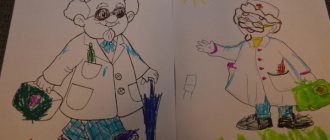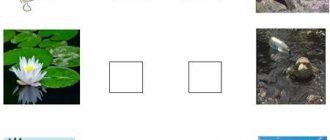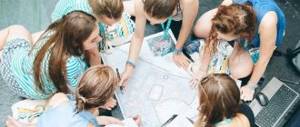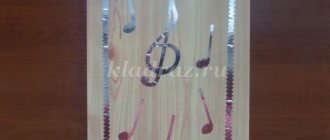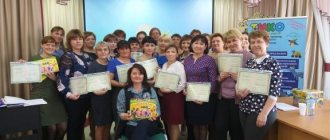Lesson summary in the 2nd junior group and its self-analysis
Verbal (reminders, instructions, questions, individual answers from children) 4. Analysis of the lesson, encouragement.
Demonstration material was prepared for each moment of the lesson: - Sleigh (theater screen) - ICT D/I “Who is hiding?” — entries: “The Joy of the Winter Forest,” educational video “Why does a bear sleep in winter?” — recordings: Music by A. Alexandrov, lyrics by M.
Evensen “Guests have come to us” (minus, P.I.
Tchaikovsky “Seasons - Winter”) Handouts: - Blanks of geometric shapes and ready-made pictures, cotton wool, sheets of A4 paper according to the number of children, - Plates for applique details, - Glue, brushes, oilcloths, napkins according to the number of children. Music was used during the lesson to enhance emotional perception. I believe that the form of organizing the lesson for children that I chose was quite effective. Disadvantages: 1.
Attention
She encouraged timid children and praised them in order to consolidate their situation of success. During the lesson, I tried to communicate with the children on the same level, and tried to maintain the children’s interest in the lesson throughout the entire time.
The outcome of the lesson was organized in the form of a game problem situation “Guess the treat?” so that during the course of it we can check the quality of assimilation of the material. Due to the fact that the children are small and there were many choral answers, I plan to pay special attention to individual answers.
It is also necessary to achieve clear pronunciation of words.
Work on sound pronunciation, expand active and passive vocabulary. But, despite these difficulties, I believe that all the program tasks I set during the lesson were solved.
Summary and self-analysis of nodes on speech development in the 2nd junior group
Program content: - develop the ability to clearly pronounce words and short phrases, speak calmly, with natural intonation; - develop motor skills of the speech apparatus, auditory perception, speech hearing; - continue to teach how to form words by analogy; -contribute to the development of intonation expressiveness of speech; -continue to develop the ability to perform movements in accordance with the text. Material: doll, soap, soap dish, sugar, sugar bowl, bread, bread box, napkins, napkin holder, toy cat. Course of the lesson 1. Didactic game “Wind-up toys” - The doll Masha came to visit us. Let's say hello to her: “Hello, Masha!”
Lesson outline (junior group) on the topic: self-analysis
Important
Self-analysis of a complex lesson in the second junior group “Balapan”. Topic: “Snowy winter” Educator: Ikomashkina Antonina Sergeevna.
Goal: to consolidate children's understanding of winter as a time of year. Tasks:
- Strengthen children's understanding of winter as a season and a temporary phenomenon of snow.
Strengthen the skills of drawing with paints using your fingers. - Refine and consolidate knowledge of colors.
- Develop an interest and positive attitude towards drawing.
Integration of educational areas: “Communication”, “Creativity”, “Health”, “Society”. Preliminary work: conversations about the winter season, guessing riddles, reading works, looking at plot paintings.
Individual work: - Continue teaching how to answer questions (repeat after the teacher) Kristina P., Matvey F., Ilyusha Ch.; — Cultivate endurance in Anyuta V. by asking her more difficult questions.
Class materials
Visual methods: pictures of a chicken, ready-made paper blanks for a chicken, glue, brush, napkin. Throughout the entire lesson, I paid attention to the children’s speech: I sought complete answers, posed searching questions, created conditions for dialogue with the children, etc.
To satisfy the physical activity of the children and maintain their health, I organized physical education, I constantly monitored the seating of the children. During the lesson, the children were active, remained interested, and were attentive.
To summarize the lesson, I involved the children in this and asked them to speak on the topic: “Who did we meet in the poultry yard?” Was able to create a situation of success. Throughout the entire NOD, I tried to support children’s cognitive interest with emotional and intonationally expressive speech. When addressing children, I used accessible questions. She took into account the individual capabilities of each child.
Self-analysis of classes in the first junior group 2
The specifics of working with children of different age groups and different levels of preparedness of children (due to the different time spent in kindergarten and different ages of children) were reflected in the person-oriented approach. Older children and those who had been attending the group for a longer time were asked more complex questions.
She encouraged timid children and praised them in order to consolidate their situation of success. During the lesson, children's behavior skills were practiced (listen carefully to tasks, show restraint). She regulated and directed the children's behavior during the lesson, maintaining the children's interest in the lesson throughout the entire time. The lesson was summed up.
The children have mastered the material.
Sample. self-analysis activities in kindergarten
Develop children's sense of familiarization with the qualities of objects (soap, towel). Cultivate neatness and friendly relationships. Teach children to understand speech addressed to them. Enrich children's vocabulary (scented, aromatic soap, soft, fluffy towel). Arouse in children a joyful mood, activity, using games, nursery rhymes, introducing an unexpected character, encouragement.
Individual work: - Continue to teach how to answer questions (repeat after the teacher), Maxim P, Nastya V, Nastya S. - Inactive, shy Eva B. - help gain confidence in his abilities, encouraging him to answer the questions asked.
— Develop self-control in Ksyusha K. by asking her more difficult questions. — Teach non-talkative Timofey, Nikita, Vladik to answer questions by showing. Methods and techniques: - Surprise moment. — Creating a game situation, artistic expression.
— Phys. just a minute.
Source: https://yuristrb-ufa.ru/konspekt-zanyatiya-vo-2-mladshej-gruppe-i-ego-samoanaliz/
Self-analysis of gaming activity in the second junior group
animals, hoops, balls, geometric shapes, flowers, pieces of maps, numbers, a jar of water, a jar of vitamins, a chest, paths, green tulle. To conduct this OOD, the following was compiled: The techniques in the lesson were of a playful nature and were based on game-based learning situations, in accordance with the Federal State Educational Standard.
The creation of search, problem situations activated the mental and speech activity of the children. During the lesson, we were always in the position “together” with the children, on the same level, and tried to maintain the children’s interest in the lesson throughout the entire time.
Summing up the results of the lesson was organized in the form of reflection, using the method of analyzing the success of completed tasks and the method of self-assessment by children of their achievements.
Introspection of the role-playing game: “Shop”
.
e. led the children to the development of the plot of the game. Each child was given the opportunity to express themselves, all children received roles. We distributed the roles according to the wishes of the children.
I believe that the children had a strong interest in the game thanks to the created conditions, preliminary conversations, viewing the picture, and preparing attributes through the joint efforts of the children and teachers. The children “lived” the accepted role, tried to follow the rules, and interacted with each other.
As a teacher, I tried to develop in children the ability to correlate the name of the role with a certain set of actions and attributes; use different types of relationships between different role positions. The following can be said about the cognitive activity of my children: The children were interested, attentive, active, and friendly. Independence was observed in verbal communication with others.
I think the introduction of attributes into the game is pedagogically justified.
Lesson summary in the 2nd junior group and its self-analysis
He helped me reveal the topic in a bright, interesting and informative way.
To ensure children's interest in the topic and emotional response to it, I used the motivation to find out where the magic feather will lead us.
To solve the first problem, I used verbal methods: explanation, reminder, demonstration, questions, visual methods: pictures of poultry.
To solve the second problem I used.
To implement each task, techniques were selected in an interesting and entertaining form. At every moment of the lesson there were visual aids that stimulated and activated the children’s mental activity.
There were 10 children present at the lesson.
Self-analysis activities 2 ml g mats for human figures
2.
Direct educational activities were built using elements of modern educational technologies: individually differentiated training, developmental didactic aids.
Individualization of learning was manifested in providing children who had difficulty completing tasks with assistance, reminders, and additional
Self-analysis of classes in the first junior group Let's teach the doll Masha to wash herself
She took into account the age and individual capabilities of the children.
Music was used during the lesson to enhance emotional perception.
Compliance with SanPin during the lesson Didactic activities of the teacher Techniques during the lesson were of a playful nature, based on game-based learning situations in which children were encouraged to engage in independent activities and apply their accumulated experience. During the lesson, I tried to communicate with the children on the same level, “eye to eye,” and not dominate the children.
The relationship between me and the children was built on the subject-subject principle. I tried to be in a “nearby” position. But while washing, I made a mistake - along with verbal instructions on how to stand up so as not to disturb each other, I allowed myself to rearrange the children.
During the lesson, children's behavior skills were practiced (listen carefully to tasks, show restraint, take turns).
Self-analysis of direct educational activities in the II junior health group
I think it turned out to be part III - the final one, where the event was summed up with the help of children’s answers to the question “who helped find the sun?” I believe that this event achieved the planned program content.
From the very beginning of the activity, the children were ready to solve the problem situation of “finding the sun,” as they were confident in the guiding help on my part. A variety of tasks ensured that all children were kept busy, taking into account their abilities.
I believe that the activity is developmental in nature.
The event went well. -I was afraid that the children would become withdrawn since it was the beginning of the school year.
-Lack of skills in answering questions. -Insufficient ability to act in a group of peers. A sample calendar planning of educational activities taking into account physical education.
Self-analysis of the teacher using different technologies in the second junior group
At this stage, I wanted to arouse children’s interest in further activities - to get into a fairy tale.
I think it turned out to be part III - the final one, where the event was summed up with the help of children’s answers to the question “who helped find the sun?” I believe that this event achieved the planned program content.
Direct educational activities were built using elements of modern educational technologies: individually differentiated training, developmental didactic aids.
Self-analysis of the theatrical game
There was a positive attitude towards the game. 4.My help was only needed to correctly show the construction techniques to the children and get them interested.
5. I pointed out to myself for the future that construction games are useful for children of this age, as they develop coherent speech, attention, logic, and perseverance.
Theme of the game: didactic game “Katya the doll woke up.” Age group: second youngest group.
Place of the game during the day: 1st half, in the morning. Goal: to consolidate children's knowledge about the name of the doll's clothes: T-shirt, panties, dress, shoes, socks; about the sequence of the dressing process; practice the actions of dressing a doll; activate children's speech; cultivate a caring attitude towards the doll. Play equipment: 2 dolls: large and small, clothes, crib.
Techniques for motivating children: a surprise moment.
Source: https://razvodved.ru/samoanaliz-igrovoj-dejatelnosti-vo-vtoroj-mladshej-gruppe-72254/
